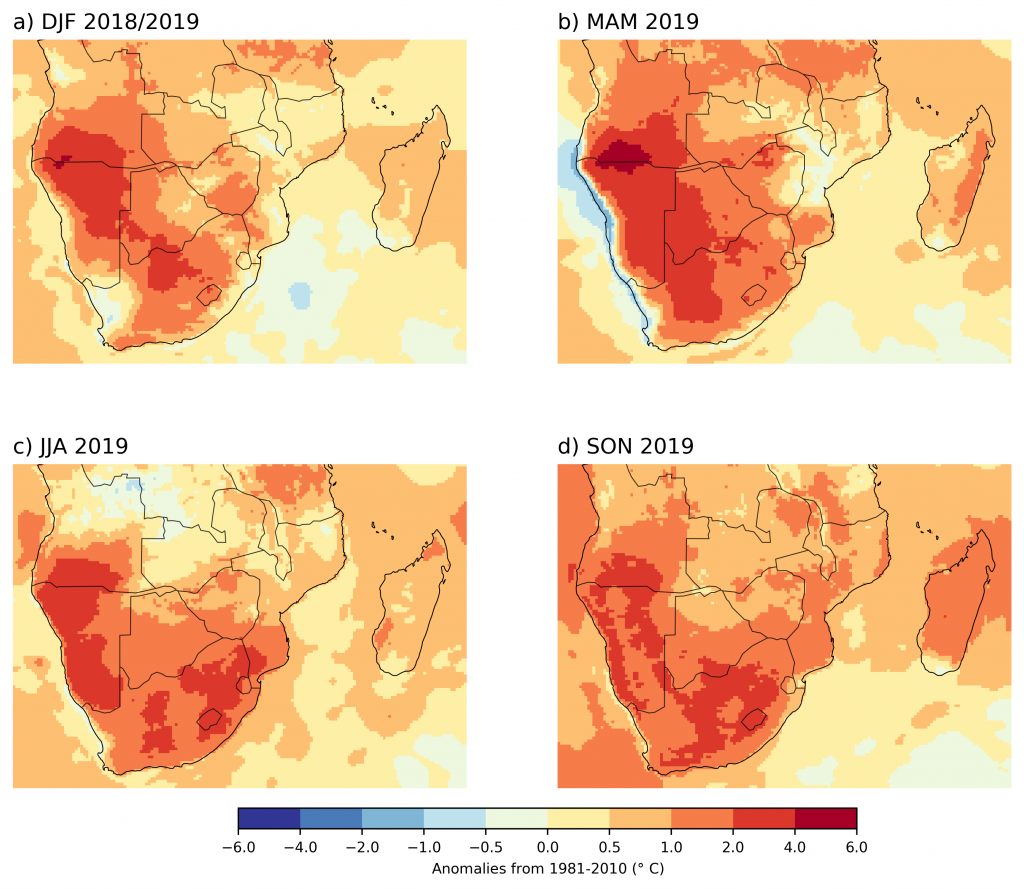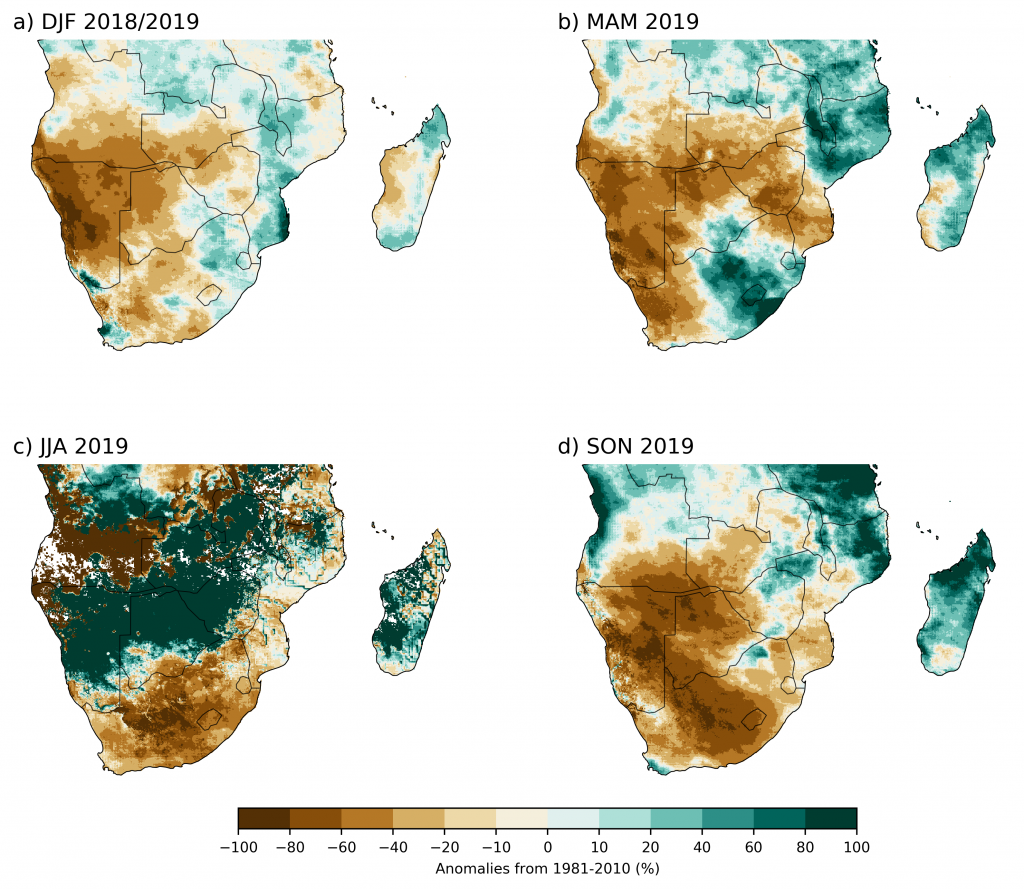The 2019 State of the Climate Report was released in the second week of August 2020 and it provides a detailed update of a set of parameters that describe the changing climate. The report offers insight on global climate indicators, including: greenhouse gases, temperatures (ocean and land), rainfall, cloud cover, sea level, ocean salinity, sea ice extent and snow cover. Furthermore, the report shows upwards trends of these indicators consistent with a warming world.
The major greenhouse gases concentrations have continued to increase and the global annual average atmospheric CO2 concentration was 409.8 parts per million (ppm) in 2019. This was the highest in the modern instrumental record and in ice core records dating back 800 000 years. Global surface temperatures were near-record high. Annual global surface temperatures were 0.44°-0.56°C above the 1981-2010 average and in Africa, the year 2019 was the third warmest year on record, behind 2016 and 2010. These key findings and others are available from the State of the Climate in 2019.
Unfortunately, this year’s report does not include analysis for the Southern Africa region, comprising SADC (Southern African Development Community) countries and located south of 6°S between the Atlantic and Indian Oceans.
In light of this I used temperature and rainfall as indicators to explore the 2019 climate conditions over the region. For temperature I used ERA5 data[1] and for rainfall I used CHIRPS data[2] and the climatological base period of 1981-2010 as in the report.
Temperature:
Temperatures over the region were mostly above normal during all seasons, with some countries experiencing more than 2°C above normal (Figure 1).

Rainfall:
The region has two distinct seasons – a wet season starting in November and ending April and a dry season from May to October, except for the Western Cape Province in the south-west of South Africa, which has a Mediterranean climate and receives most of its rainfall in the austral winter months (June – August).
Dry conditions persisted over parts of Angola, Namibia, Zambia, Botswana, Zimbabwe, South Africa and Mozambique the region throughout the seasons (Figure 2).
During the austral summer (DJF, Figure 2(a)), the majority of Mozambique, parts of Democratic Republic of Congo, eastern parts of South Africa including Western Cape experienced above normal rainfall.
The most significant feature of the rainfall during 2019 was the wet conditions observed over Mozambique, Malawi and Zimbabwe during MAM (Figure 2 (b)). The excessive rainfall during MAM was caused by tropical cyclones (TC) Idai and Kenneth. Idai caused catastrophic damage of at least $2.2 billion (U.S. dollars), and a humanitarian crisis in Mozambique, Malawi and Zimbabwe. It was considered the costliest TC on record for the South Indian Ocean basin, as well as the deadliest [3]. During MAM above rainfall conditions were also experienced in Lesotho and parts of South Africa, including the KwaZulu-Natal (KZN) Province. These conditions were contributed due to a passage of a cut-of-low which caused floods in KZN province. These floods lead to a death of 71 people and more than a 1000 have been displaced [4,5].
Above normal conditions were also experienced over Tanzania during SON (Figure 2 (d)). This was one of the wettest seasons in that part of the region and the rains were associated with the positive Indian Ocean dipole (IOD)[6]. Over parts of Madagascar above normal rainfall were experienced throughout the year.
JJA (Figure 2 (c))is the main dry season over the region and parts of some countries experienced some amount of rainfall.

Figure 2 Southern Africa seasonally averaged mean rainfall anomalies (% of mm/day; 1981–2010 base period) for (a) DJF 2018/19, (b) MAM 2019, (c) JJA 2019, and (d) SON 2019. (Source: CHIRPS)
In the regions spanning southern Mozambique, Zimbabwe, western Zambia, eastern South Africa, dry conditions have continued into 2020 impacting the 2019-2020 growing season [7]. The effects of the prolonged dry conditions are mainly agricultural, resulting in food insecurity.
References
[1] https://www.ecmwf.int/en/forecasts/datasets /reanalysis-datasets/era5
[2] https://www.chc.ucsb.edu/data/chirps
[3] Bissolli, P., C. Ganter, T. Li, A. Mekonnen, and A. Sánchez-Lugo, Eds., 2020: Regional Climates [in “State of the Climate in 2019″]. Bull. Amer. Meteor. Soc., 101 (8), S321–S420.
[4] https://www.bbc.com/news/world-africa-48036252
[5] https://www.timeslive.co.za/news/south-africa/2019-05-02-killer-kzn-floods-are-declared-a-provincial-disaster/
[6] Wainwright, C.M., Finney, D.L., Kilavi, M., Black, E. and Marsham, J., 2020. Extreme rainfall in East Africa October 2019–January 2020 and context under future climate change. Weather
[7] Wolski, P., Lobell, D., Stone, D., Pinto, I., Crespo, O. and Johnston, P., 2020. On the role of anthropogenic climate change in the emerging food crisis in southern Africa in the 2019–2020 growing season. Global Change Biology, 26(5), pp.2729-2730.
